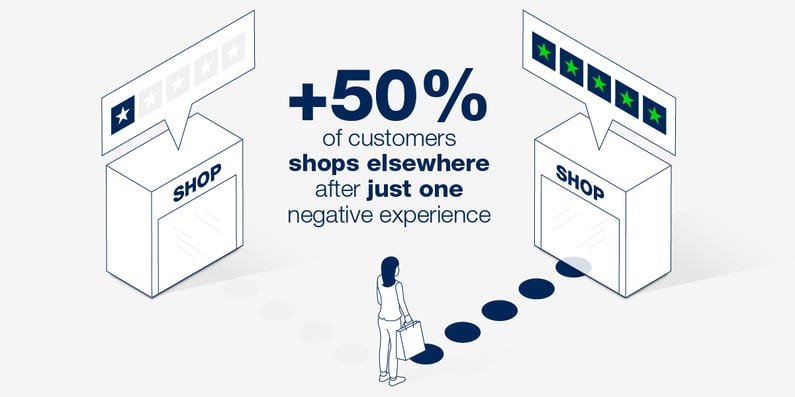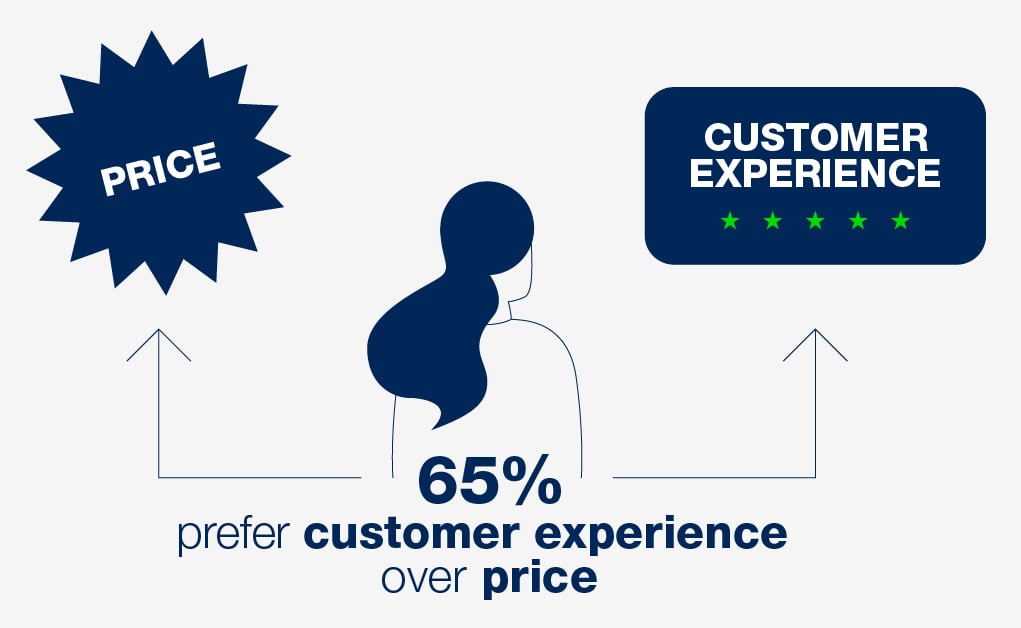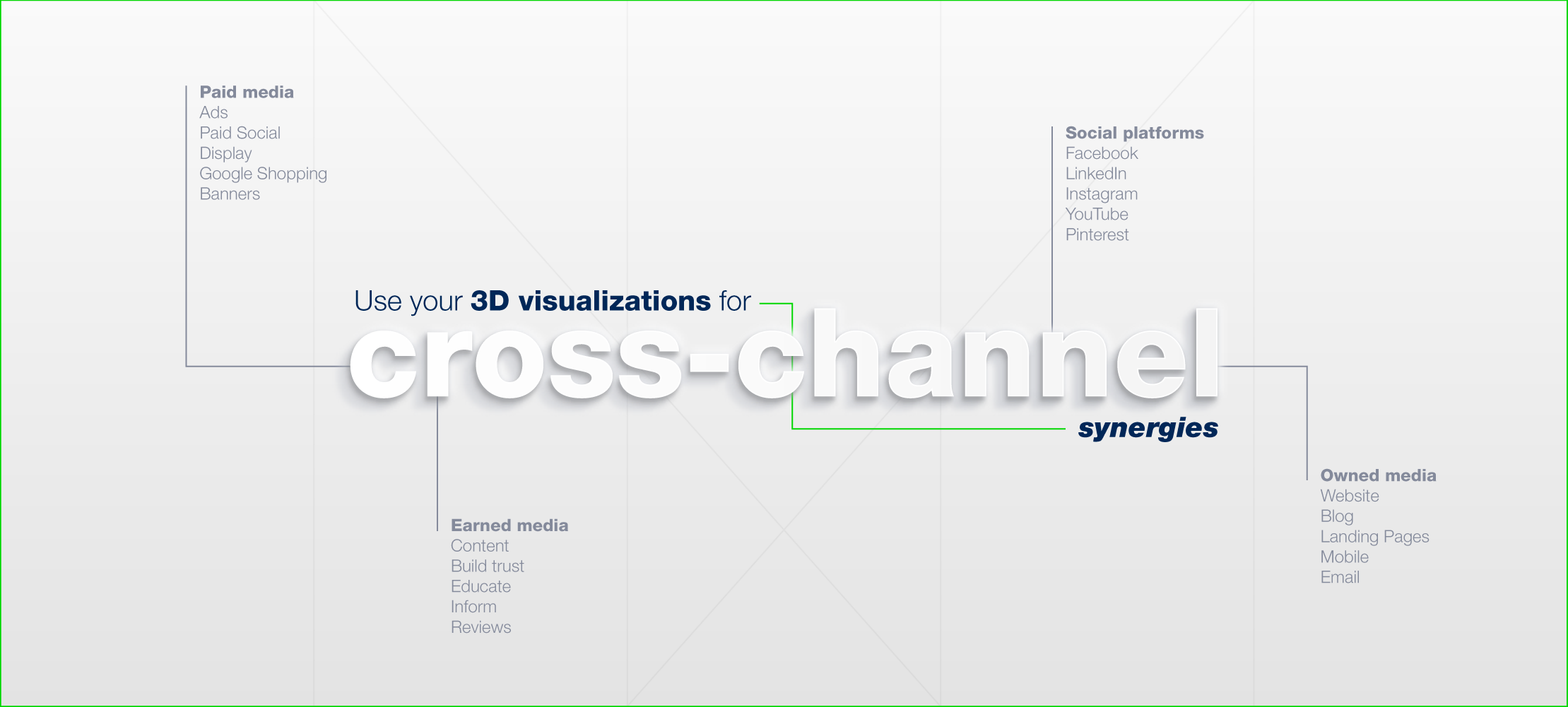Today’s consumers want more than just competitive prices for the products or services they purchase. They want a rewarding customer experience as well, and if they don’t get it from one company, they’ll go to another. If you think this is an exaggeration, consider that just over 50% of customers will stop doing business with a company after just one negative experience.

Customers define a negative experience in a number of ways, including:
- Poor customer service
- Difficult purchasing process
- Lack of information about products or services
- Overpriced products
- Poor quality products
- Feeling unappreciated as a customer
So as you can see, a negative customer experience can make a significant impact on sales. But a positive customer experience can be a great boon to your ROI as well, when you consider that nearly 65% of consumers consider the customer experience to be more important than the price of a product or service. In fact, consumers are willing to pay more if the customer experience is excellent. And if you’re industry or market is especially competitive, delivering a great customer experience can mean the difference between gaining or losing a strong loyal customer.

What is customer experience?
Put simply, customer experience is the impression you have of an organization you choose to do business with. As a business owner or manager, it is up to you to ensure that a customer or client has a good customer experience from the beginning of their customer journey to the end, or you risk losing their business forever.
Imagine walking into a store, navigating to the aisle where your product is, purchasing the product at the checkout lane, and then going home. What kind of experience was this? You got exactly what you wanted without any fuss, so it’s safe to say you had an okay experience, but nothing special about it.
But suppose you didn’t know exactly where your product was, and it was hard to find a customer service associate to help you. Or suppose someone did help you but didn’t appear very knowledgeable or friendly. Suppose the cashier was moving very slow, causing you to wait on line for longer than should be necessary. Suppose none of the employees really seemed like they wanted to work there, or the store was dirty, unorganized, and products were overpriced.
Any of the above criteria would probably cause you to have a negative customer experience and make you think twice about shopping there again.
On the other hand, if you were greeted in friendly manner upon entering the store, sales associates were smiling, knowledgeable, and helpful, the store was well-lit and organized, and the cashier was also friendly, you’d have a great customer experience, and likely frequent this store again.
Today, customer experience is everything, and this rule applies to online brands as well as brick and mortar establishments. Businesses of all sizes, in all industries, are striving to improve the customer experience. Many are seeking to push the envelope in order to stand out from their competitors, providing extraordinary customer experiences via VR and AR technologies or by improving product functionality via product configurators.

4 reasons why customer experience is important for a business
Why do nearly 70% of marketers devote their focus to improving the customer experience? The answer is fairly simple: satisfied customers remain loyal customers. This definitely isn’t a new, earth-shattering concept by any means, but in recent years, as competition among both brick and mortar stores and the online marketplace has seemed to increase exponentially, customer satisfaction is more important than ever before.
That’s because in a technology-driven world, one customer who has a negative experience can share their story with potentially thousands within seconds, which can be detrimental to a business. On the other hand, customers who have a positive experience can do the same, and often go so far as to promote the business on their own, which makes them both a valued customer and a valuable marketing asset.
Consider some of the other benefits of providing a positive customer experience:
1. An increase in brand recognition and brand loyalty
Because today’s consumers base many of their purchase decisions on what they experience throughout their customer journey, delivering a positive experience along the way improves brand recognition and ultimately brand loyalty if the journey concludes in a superior manner.
2. Free marketing that potentially increases your customer base
Although it may not always seem like it, according to an American Express study, American consumers post more positive reviews (53%) than negative ones (35%) on social media and review platforms. Consumers often turn to reviews by others before making a purchase decision, so positive reviews by satisfied customers have the potential to convert new prospects. Treat your new customers just as well, and the cycle continues.
This can be a critical component to the success of a company — gaining new customers can cost 7 times more than maintaining your existing customer base. But if your satisfied customers are doing the work for you, delivering a positive customer experience has just become significantly more cost-effective.
3. You stand out from competitors
It doesn’t matter if you manufacture auto parts or medical equipment, if you provide home improvement or construction services, or if you manage a large industrial plant — chances are you’ve got competition, and lots of it.
In the old days, competitors fought for their share of the target market via price wars, but such tactics are outdated. Today, the customer experience makes all the difference, and what you do for your customers; how you treat them, how you greet them, how you show them that you value them as a customer; can truly separate you from the herd and propel you forward to success.
4. Increase your ROI
Providing excellent customer experiences and achieving all of the above will result in a massive increase to your ROI. Why struggle with redundant marketing plans and strategies that don’t deliver optimal benefit when the key is simply making sure your customers are as happy as can be?
Focus instead on customer service and fulfilling the wants and needs of your target market, as well as meeting and exceeding their expectations, and you’ll create a team of consumer advocates that do a significant amount of the marketing for you.
Delivering a positive customer experience online
So what is the customer experience like online? Some of the ideals are the same — just as a storefront makes a first impression on a consumer, so too does your website. And just as a customer in a brick and mortar store wants to find the product they are searching for quickly, so too do visitors to your site want to find the information they seek without having to navigate through too many pages.
There are many ways to improve the customer experience online, from always delivering high-quality images, video, and sales tools, to being able to meet consumer demand and bring new products to the market swiftly.
But many of your competitors are likely also already doing this, so what can you do to outdo them, and deliver a superior customer experience that will get new loyal customers talking about you?
Online consumers, and especially the millennial market, place a lot of stock in online engagement. They don’t want to purchase products or services from faceless corporations that don’t seem to place any value on the consumer. Instead, they want to engage with the company on a more personal level, either through social media posts, 3D visualization, and interactive sales tools. All of these help to create great customer experiences and can even be tailored to provide a more personal level of engagement that really resonates with the consumer.
It also serves to build a relationship of trust, another critical component in building a long-lasting relationship.
Consider how you can leverage the ever-advancing technology we have at our disposal today to better connect with your target market, and you’ll maintain a strong edge over your competitors and increase your customer base and your revenue.















